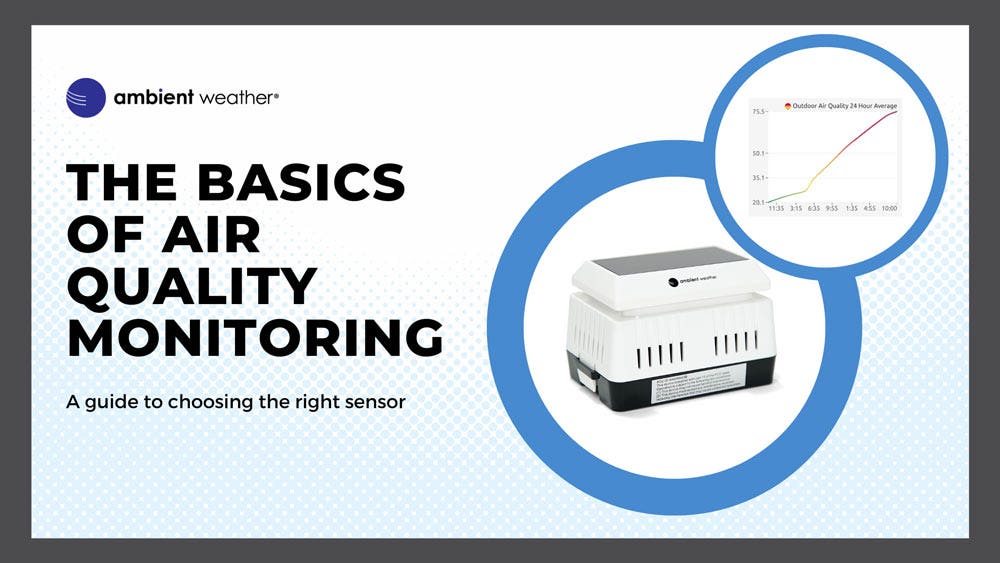The Basics of Air Quality Monitoring

Take a deep breath and consider this: the air you're inhaling might not be as safe as you think. But how can you tell if the air around you is safe to breathe? Ambient Weather can help you better understand your air quality levels in and around your home through easy-to-use sensors that connect to your Ambient Weather Station. Let's breathe easy together and dive into the basics of air quality measurements and finding the right detector for you.
What is Air Quality Monitoring?
It's the key to unlocking a deeper understanding of the invisible world around us – the air we breathe. Air quality monitoring measures the pollutant levels in the air around you, inside and outside. With air quality monitoring, you gain vital insights into the level of particles in the air that could affect your health and well-being. Utilizing one of our air quality sensors from Ambient Weather will provide you with real-time particulate matter and carbon dioxide data. With this knowledge, you can make informed decisions to create a healthier living environment for you and your loved ones.
What is PM2.5, and why should you measure it?
PM2.5 refers to fine particulate matter, tiny particles in the air with a diameter of 2.5 micrometers or less. To give you an idea of how small 2.5 micrometers is, a human hair is about 70 micrometers. Despite their minuscule size, these particles can significantly impact our health, as they can penetrate deep into our respiratory system and even enter our bloodstream. PM2.5 is often associated with various health issues, including respiratory diseases, cardiovascular problems, and aggravated allergies. Monitoring PM2.5 levels is crucial because it allows you to assess the air quality and understand potential health risks associated with high concentrations of these harmful particles.
What is PM10, and why should you measure it?
PM10 refers to slightly larger particles in the air with a diameter of 10 micrometers or less. It is often caused by coarser pollutants from mechanical operations (construction), mold, and pollen. When PM10 levels are elevated, they can irritate the respiratory system and exacerbate existing respiratory conditions. Monitoring PM10 is essential as it provides valuable information to give you a complete picture of your overall air quality and potential sources of pollution in your surroundings.
What is CO2, and why should you measure it?
CO2, or carbon dioxide, is a colorless, odorless gas naturally present in the Earth's atmosphere. While it is an essential part of the carbon cycle and necessary for plant life, excessive levels of CO2 indoors can have adverse effects on our health and well-being. High CO2 concentrations can lead to stuffy indoor environments, drowsiness, and reduced cognitive function. Monitoring CO2 levels is vital as it helps you maintain adequate ventilation and prevent indoor air quality degradation.
Which sensor is right for me?
PM2.5 Particulate Monitoring
According to the EPA, PM2.5 poses the greatest health risk of these particles. For those specifically interested in monitoring PM2.5 levels indoors, the Ambient Weather PM25IN® Wireless Indoor Particulate Monitor is an excellent option. This sensor seamlessly connects to your Ambient Weather Station and sends all the PM2.5 data to the Ambient Weather Network (AWN). On the other hand, if you need to track PM2.5 levels outdoors, you can also add the Ambient Weather PM25® Wireless Outdoor Particulate Monitor, which provides accurate readings of outdoor PM2.5 levels. Whether you want to focus on indoor or outdoor air quality, Ambient Weather has the perfect sensor to suit your monitoring needs and empower you with the information to create a healthier and safer living environment. Our indoor and outdoor PM2.5 sensors are compatible with the following Ambient Weather Stations: WS-1965, WS-2902, WS-2000, WS-5000.
Click here to learn more about the PM25IN Wireless Indoor Particulate Monitor.
Click here to learn more about the PM25 Wireless Outdoor Particulate Monitor.
Comprehensive Air Quality Monitoring
If you require comprehensive indoor air quality data, the Ambient Weather AQIN Air Quality Particulate Monitor is an ideal choice. This sensor measures indoor PM2.5, PM10, and Carbon Dioxide (CO2) concentrations, providing valuable insights into the air's composition. Effortlessly monitor your air quality on your Ambient Weather Network (AWN) dashboard and set alerts for unfavorable conditions. The AQIN sensor is compatible with the following Ambient Weather Stations: WS-1965, WS-2000, and WS-5000.
Click here to learn more about the AQIN Air Quality Monitor.
Air quality monitoring is an essential tool everyone can use to protect their health and the health of their loved ones. By understanding the basics of air quality monitoring, like PM2.5, PM10, and CO2 levels, you can take steps to reduce your exposure to pollutants. Get your hands on our Ambient Weather monitors today to keep your family safe and healthy!










